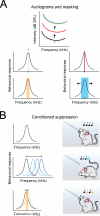Rodent auditory perception: Critical band limitations and plasticity
- PMID: 25827498
- PMCID: PMC4426073
- DOI: 10.1016/j.neuroscience.2015.03.053
Rodent auditory perception: Critical band limitations and plasticity
Abstract
What do animals hear? While it remains challenging to adequately assess sensory perception in animal models, it is important to determine perceptual abilities in model systems to understand how physiological processes and plasticity relate to perception, learning, and cognition. Here we discuss hearing in rodents, reviewing previous and recent behavioral experiments querying acoustic perception in rats and mice, and examining the relation between behavioral data and electrophysiological recordings from the central auditory system. We focus on measurements of critical bands, which are psychoacoustic phenomena that seem to have a neural basis in the functional organization of the cochlea and the inferior colliculus. We then discuss how behavioral training, brain stimulation, and neuropathology impact auditory processing and perception.
Keywords: audition; behavior; hearing; mouse; plasticity; rat.
Copyright © 2015 IBRO. Published by Elsevier Ltd. All rights reserved.
Figures

Similar articles
-
Corticofugal reorganization of the midbrain tonotopic map in mice.Neuroreport. 2001 Oct 29;12(15):3313-6. doi: 10.1097/00001756-200110290-00033. Neuroreport. 2001. PMID: 11711877
-
[Corticofugal modulation and plasticity for hearing].Sheng Li Ke Xue Jin Zhan. 2005 Apr;36(2):175-8. Sheng Li Ke Xue Jin Zhan. 2005. PMID: 16222985 Review. Chinese. No abstract available.
-
Passive stimulation and behavioral training differentially transform temporal processing in the inferior colliculus and primary auditory cortex.J Neurophysiol. 2017 Jan 1;117(1):47-64. doi: 10.1152/jn.00392.2016. Epub 2016 Oct 12. J Neurophysiol. 2017. PMID: 27733594 Free PMC article.
-
Learning to hear: plasticity of auditory cortical processing.Curr Opin Neurobiol. 2007 Aug;17(4):456-64. doi: 10.1016/j.conb.2007.07.004. Epub 2007 Aug 21. Curr Opin Neurobiol. 2007. PMID: 17714932 Review.
-
Prolonged low-level noise-induced plasticity in the peripheral and central auditory system of rats.Neuroscience. 2017 Sep 17;359:159-171. doi: 10.1016/j.neuroscience.2017.07.005. Epub 2017 Jul 13. Neuroscience. 2017. PMID: 28711622 Free PMC article.
Cited by
-
Positive impacts of early auditory training on cortical processing at an older age.Proc Natl Acad Sci U S A. 2017 Jun 13;114(24):6364-6369. doi: 10.1073/pnas.1707086114. Epub 2017 May 30. Proc Natl Acad Sci U S A. 2017. PMID: 28559351 Free PMC article.
-
Wide sensory filters underlie performance in memory-based discrimination and generalization.PLoS One. 2019 Apr 18;14(4):e0214817. doi: 10.1371/journal.pone.0214817. eCollection 2019. PLoS One. 2019. PMID: 30998708 Free PMC article.
-
The rat animal model for noise-induced hearing loss.J Acoust Soc Am. 2019 Nov;146(5):3692. doi: 10.1121/1.5132553. J Acoust Soc Am. 2019. PMID: 31795685 Free PMC article. Review.
-
Stimulus Generalization in Mice during Pavlovian Eyeblink Conditioning.eNeuro. 2022 Mar 22;9(2):ENEURO.0400-21.2022. doi: 10.1523/ENEURO.0400-21.2022. Print 2022 Mar-Apr. eNeuro. 2022. PMID: 35228312 Free PMC article.
-
Vagus nerve stimulation recruits the central cholinergic system to enhance perceptual learning.Nat Neurosci. 2024 Nov;27(11):2152-2166. doi: 10.1038/s41593-024-01767-4. Epub 2024 Sep 16. Nat Neurosci. 2024. PMID: 39284963
References
-
- Bauer PW, Sharma A, Martin K, Dorman M. Central Auditory Development in Children With Bilateral Cochlear Implants. Arch Otolaryngol Head Neck Surg. 2006;132:1133–1136. - PubMed
Publication types
MeSH terms
Grants and funding
LinkOut - more resources
Full Text Sources
Other Literature Sources

